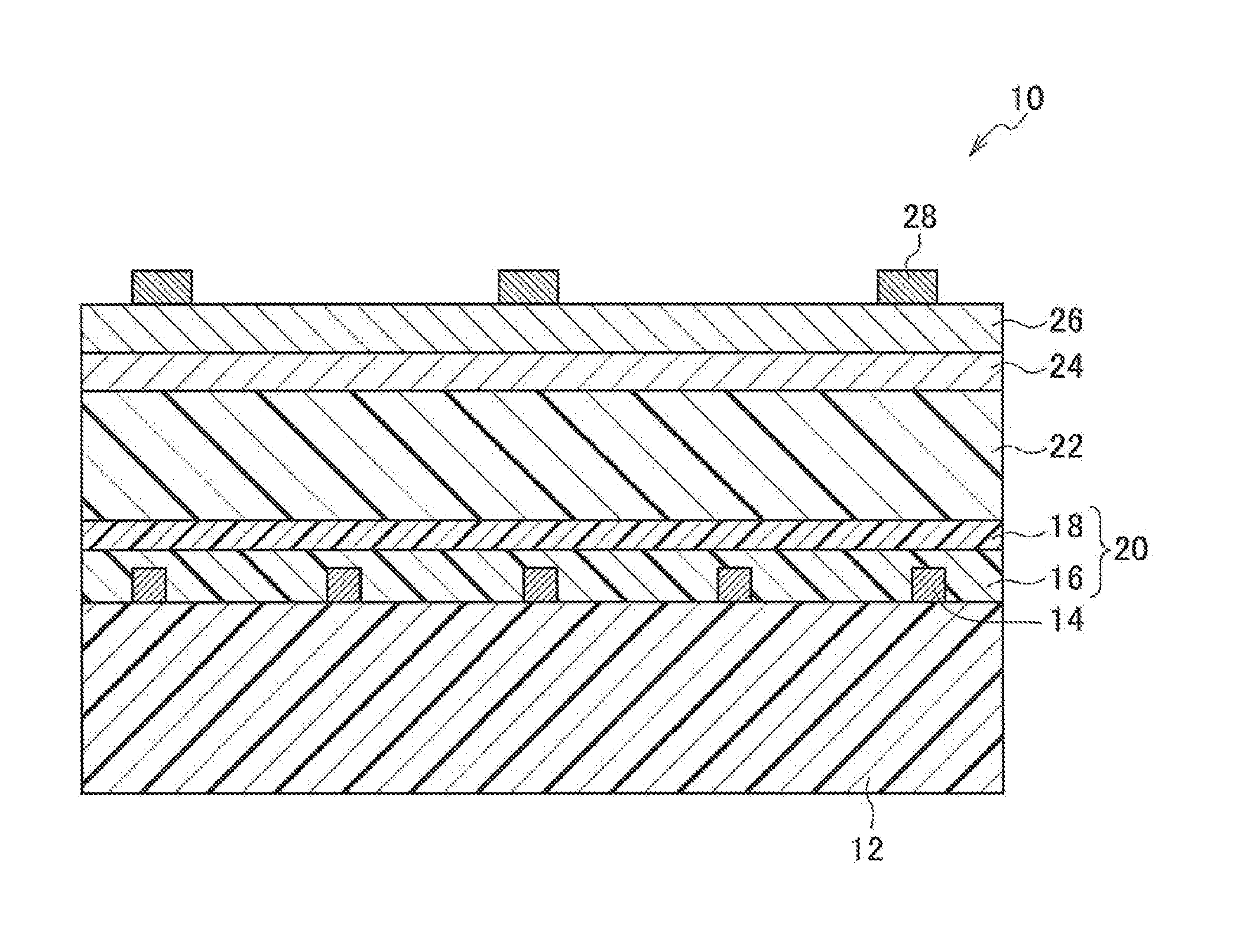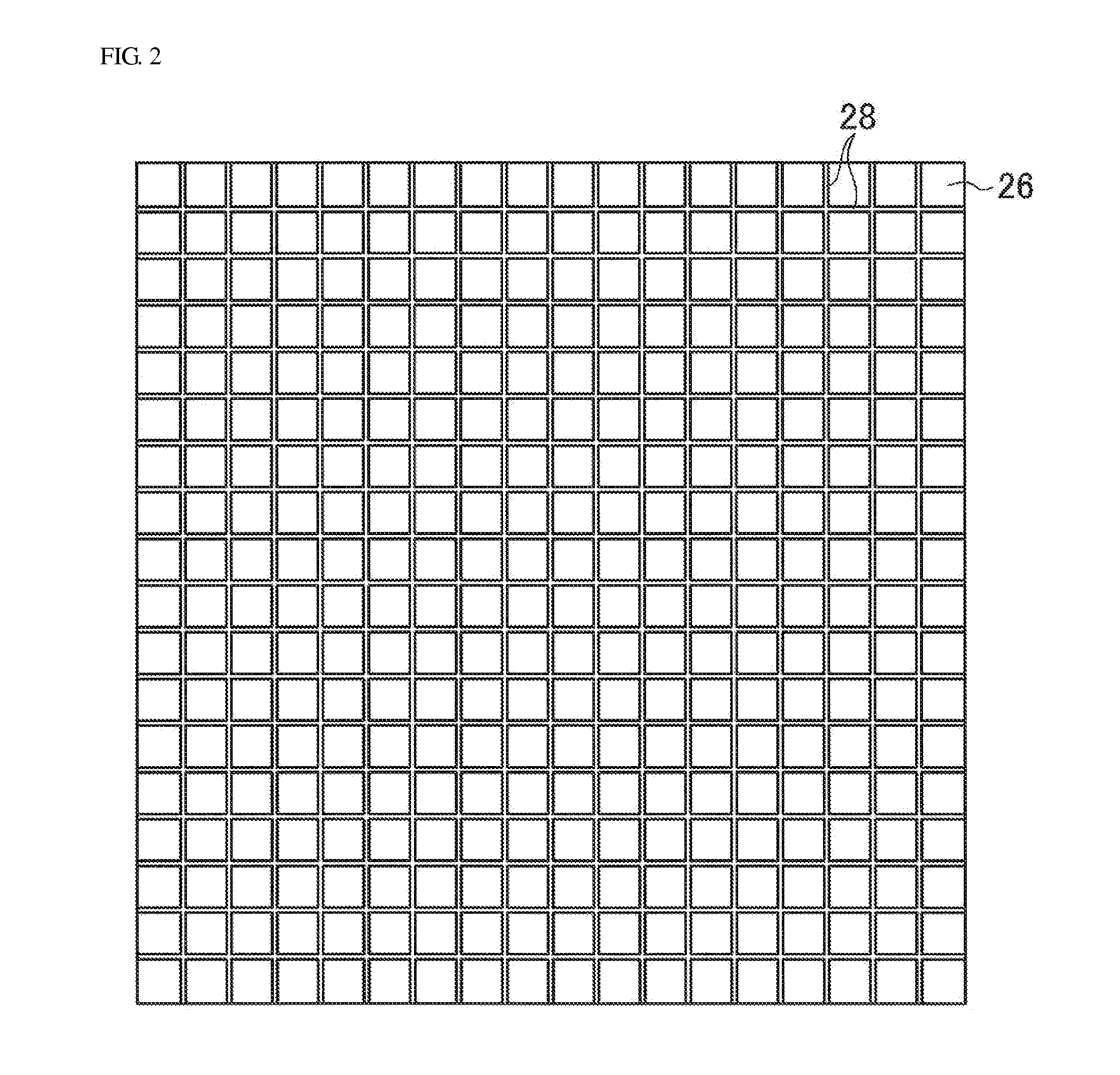Solar cell
a solar cell and cell technology, applied in the field of solar cells, can solve the problems of increasing electrode resistance, increasing manufacturing costs, and rising materials, and achieve the effect of deteriorating photovoltaic characteristics
- Summary
- Abstract
- Description
- Claims
- Application Information
AI Technical Summary
Benefits of technology
Problems solved by technology
Method used
Image
Examples
example 1
[0128][Formation of Additional Electrode for Positive Electrode]
[0129][Preparation of Silver Halide Emulsion]
[0130]In a reaction vessel, the following solution A was maintained at 34° C., and was adjusted to a pH of 2.95 using nitric acid (concentration: 6%), while being agitated at high speed using a mixing-agitation device described in JP-A No. 62-160128. Subsequently, the following solution B and the following solution C were added thereto at a constant flow rate over 8 minutes 6 seconds using a double-jet method. After the addition was completed, the pH of the resulting mixture was adjusted to 5.90 using sodium carbonate (concentration: 5%) and then, the following solution D and solution E were added thereto.
[0131](Solution A)
Alkali-processed inert gelatin (average 18.7 gmolecular weight: 100,000)Sodium chloride 0.31 gSolution I (described below) 1.59 cm3Pure water1,246 cm3
[0132](Solution B)
Silver nitrate169.9 gNitric acid (concentration: 6%) 5.89 cm3Pure water was added to give...
example 10
[0170][Formation of Additional Electrode for Positive Electrode / Positive Electrode]
[0171]The additional electrode for the positive electrode and the positive electrode were formed in a manner similar to that in Example 1.
[0172][Formation of Photoelectric Conversion Layer]
[0173]A composition obtained by dissolving P3HT and PCBM in chlorobenzene was applied to the positive electrode in a manner similar to that in Example 1, and without performing a heat treatment, a bulk heterojunction type photoelectric conversion layer was formed.
[0174][Formation of Electron Transport Layer / Additional Metal Electrode for Negative Electrode / Translucent Metal Negative Electrode]
[0175]As the electron transport layer, aluminum (film thickness: 2 nm) was vacuum-deposited on the whole surface of the photoelectric conversion layer.
[0176]Subsequently, as the additional metal electrode for the negative electrode, aluminum (film thickness: 0.4 μm) was vacuum-deposited on the electron transport layer. In this ...
examples 11 to 13
[0179]Organic thin-film solar cells were prepared in a manner similar to that in Example 10, except that the electron transport layer, the metal negative electrode, and the additional metal electrode for the negative electrode were changed as shown in Table 1, and the conversion efficiency thereof was measured.
[0180]Further, with regard to each of the organic thin-film solar cells of the Examples and the Comparative Examples, the conversion efficiency 10 days after the preparation was measured, and a relative value was determined with the initial value being designated as 1.
TABLE 1Additional metalConversionElectronelectrode forEfficiencyTransportTranslucent MetalNegativeAfter 10 DayslayerNegative ElectrodeElectrode(relative value)TitaniumGold: 10 nmAluminum:1.0Example 1oxide: 10 nm0.4 μmSilver: 0.4 μm1.0Example 2Silver: 15 nmAluminum:0.98Example 30.4 μmZinc: 0.4 μm0.97Example 4Nickel: 0.4 μm0.94Example 5Copper: 0.4 μm0.92Example 6Silver: 0.4 μm0.78ComparativeExample 1Gold: 0.4 μm0.4...
PUM
| Property | Measurement | Unit |
|---|---|---|
| Tg | aaaaa | aaaaa |
| heat resistance | aaaaa | aaaaa |
| Tg | aaaaa | aaaaa |
Abstract
Description
Claims
Application Information
 Login to View More
Login to View More - R&D
- Intellectual Property
- Life Sciences
- Materials
- Tech Scout
- Unparalleled Data Quality
- Higher Quality Content
- 60% Fewer Hallucinations
Browse by: Latest US Patents, China's latest patents, Technical Efficacy Thesaurus, Application Domain, Technology Topic, Popular Technical Reports.
© 2025 PatSnap. All rights reserved.Legal|Privacy policy|Modern Slavery Act Transparency Statement|Sitemap|About US| Contact US: help@patsnap.com



